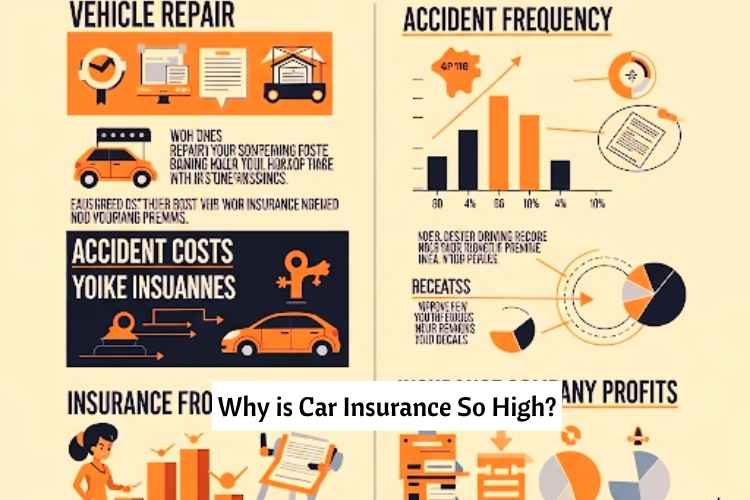Why is Car Insurance So High: Car insurance isn’t exactly something most people look forward to paying, but it’s necessary. And when that bill arrives and the number is higher than expected, it leaves many drivers wondering: “Why is car insurance so high?”
The truth is, your premium isn’t just pulled out of thin air. Insurance companies use a detailed set of criteria to calculate risk—and therefore, cost. Some factors are within your control, and others… not so much.

Table of Contents
Why is Car Insurance So High: Your Driving History

Your past behaviour behind the wheel is one of the biggest influences on your premium.
Why it matters:
Insurance is based on risk. If you’ve been in multiple accidents or collected speeding tickets, insurers see you as more likely to file a claim.
Example:
- Clean Record: Jane, 32, hasn’t had a ticket in 10 years. Her premium? $1,050/year.
- Risky Record: Mike, 29, has 2 speeding tickets and a fender bender. His? $1,880/year.
Pro Tip:
Defensive driving courses can sometimes reduce your rate, especially if you’ve had a recent violation.
Why is Car Insurance So High? Where You Live: ZIP Codes Can Make or Break Your Rate
Yes, your location plays a huge role—even if you never drive outside your neighbourhood.
Why it matters:
Insurance companies look at your ZIP code to evaluate:
- Theft and vandalism rates
- Traffic density
- Local accident statistics
- Claim history in your area
Example:
Move just a few miles from a quiet suburb into a city and your rate could jump by $500+ per year.
Age, Gender, and Marital Status: Demographics That Drive Risk
It might feel unfair, but statistics drive this part of the equation.
Why it matters:
Young, single drivers—especially males—statistically get into more accidents. Over time, rates typically drop as drivers gain experience.
Stat Breakdown:
- Teen Drivers (16-19): Highest crash rate of any age group
- Men under 25: Pay 15–20% more than women in the same age bracket
- Married drivers: Often pay less (insurers view them as more responsible)
The Car You Drive: That Sporty Coupe Might Be Costing You
It’s not just about what you drive—it’s about how expensive it is to repair, replace, and how likely it is to be stolen.
Why it matters:
- Luxury and sports cars: Higher repair costs, faster speeds → higher premiums
- Safety-rated sedans/SUVs: Lower risk → lower cost
- Popular theft targets e.g., Honda Civics, Ford F-150s, can raise rates
Quick Comparison:
| Vehicle Type | Avg Annual Premium |
|---|---|
| 2023 Toyota Camry | $1,420 |
| 2023 BMW 3 Series | $2,270 |
| 2023 Dodge Charger | $2,435 |
| 2023 Honda CR-V | $1,295 |
Credit Score: Your Financial Habits Also Count
Surprised? In most states, your credit score is a major factor in setting car insurance rates.
Why it matters:
Insurance companies say drivers with poor credit file more claims, and more expensive ones.
Exceptions:
Some states, like California, Hawaii, and Massachusetts, ban insurers from using credit scores when setting rates.
Conclusion on Why is Car Insurance So High?
Car insurance can feel mysterious, even frustrating—but it’s not random. By understanding these five key factors—your driving history, location, demographics, vehicle type, and credit—you can see where the costs are coming from.
Some things you can’t control, but many you can. Small changes—like improving your credit, avoiding tickets, or switching cars—can lead to big savings over time.
So the next time your premium feels too high, don’t just accept it—investigate it. You might be surprised at how much you can save.
Bhakti Rawat is a Founder & Writer of InsureMyCar360.com. This site Provides You with Information Related To the Best Auto Insurance Updates & comparisons. 🔗
